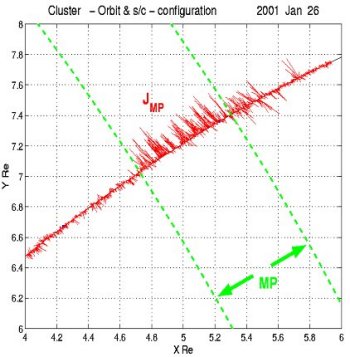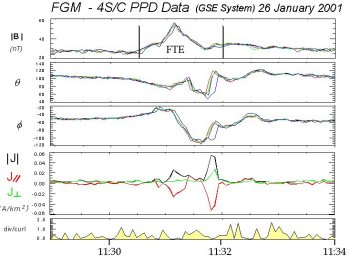Measurement of the Electric Current
28 January 2003
The prime scientific objective of Cluster is to derive physical quantities, such as the electric current density that can only be obtained by combining measurements from the four spacecraft. A first example where this has been achieved was obtained close to the external boundary of the Earth's magnetic field, in a Flux Transfer Event (FTE).A FTE is a magnetic flux tube that is connected, by magnetic reconnection, on one side to the Earth and on the other side to the solar wind. Never before have these currents been measured with such precision and without any assumption about the current structure. This new finding has important implications for modelling these structures, and how energy flows from the solar wind to the magnetosphere.
|
|
|
Figure 1. Magnetic field measured on the four spacecraft (C1 in black, C2 in blue, C3 in green and C4 in red) on 26 January 2001. The electric current is plotted in the fourth panel (From Robert and Roux et al., 2002). |
Cluster measured the magnetic field (B) in an FTE on 26 January 2001. The modulus of B, which was about 25 nT before and after the event (a typical value for the magnetosheath), exceeds 50 nT inside the structure, just after 11:31. This large increase is one of the characteristic signatures of FTE's observed in the magnetosheath. The distance between the various satellites was about 600 km, and the Cluster tetrahedron was almost regular, a situation which is favourable for calculating curl B.
Variations in the modulus of B, between the various satellites is small, less than 10%, which indicates that the size of the FTE is much larger than the distance between the spacecraft, as required to estimate curl B. There are, however, relatively large variations in the angles θ and φ, which is indicative of a rotational discontinuity. The result of the calculation of curl B, from the 4 tri-axial magnetometers, via the "curlometer" method, is displayed. There are two maximums in the modulus of the current density that reaches 25 nAm-2 (at 11:31:10) and 55 nAm-2 (at 11:31:50). Thus the current density is not homogeneous inside the FTE.
Notice that the parallel component of the current dominates, and that it is negative, which means that the current, inside the two current density sub-structures, is antiparallel to B. The last panel shows the ratio divB/CcurlB. This ratio sometimes reaches unity, but it is small (around 0.2), when the current density is large. Further analysis, not described here, shows that the FTE is a cylindrical tube moving along the direction of a nominal magnetopause, the axis of the tube is in the azimuth direction. Thus the curlometer method, applied to the 4 spacecraft shows that the FTE is a force-free structure with the current flowing along an hollow tube.
Further measurements of the electric current
Dunlop et al., have published results on measurements of the electric current in the solar wind in the heliospheric current sheet, at the magnetopause. (Dunlop et al., J. Geophys. Res., 2002)
 |
|
Figure 2. Electric current along the Cluster orbit and projected in XY plane. The model magnetopause is shown in green dashed line and the current in red. It is clear that the current is tangent to the magnetopause as expected from theoretical models. The bursty behavior of the current is due to the motion of the magnetopause (from Dunlop et al., J. Geophys. Res., 2002) |
In a paper in the Geophysical Research Letters, Slavin et al. report on measurements of the electric current made in the magnetotail inside a flux rope. (Slavin et al., Geophys. Res. Lett, 2003.)
 |
|
Figure 3. Electric current density determined using the 4 s/c curlometer technique (black) and the single s/c Lepping-Burlaga model (colour) is displayed. The ratio of the curlometer determined current parallel to the magnetic field to that perpendicular to the magnetic field is presented in the 5th panel. The error in the curlometer current, taken to be the divergence of B divided by µoJ is shown in panel 6 (from Slavin et al., Geophys. Res. Lett, 2003). |
Related Articles
P. Robert, A. Roux, D. Fontaine, P. Canu, O. Le Contel, S. Perraut, N. Cornilleau-Wehrlin, M.W. Dunlop, A. Balogh, K. H. Glassmeier, J.M. Bosqued, A. N. Fazakerley, R. Behlke, P.M.E. Décréau, Cluster Observations of A Flux Transfer Event (fte), EGS XXVII General Assembly, Nice, 21-26 April 2002, abstract #5813, 2002
M.W. Dunlop, A. Balogh, K.-H. Glassmeier, P. Robert, Four-point Cluster application of magnetic field analysis tools: The Curlometer, Journal of Geophysical Research (Space Physics), 107, Issue A11, pp. SMP 23-1, CiteID 1384, doi:10.1029/2001JA005088, 2002
J. A. Slavin, R. P. Lepping, J. Gjerloev, M. L. Goldstein, D. H. Fairfield, M. H. Acuna, A. Balogh, M. Dunlop, M. G. Kivelson, K. Khurana, A. Fazakerley, C. J. Owen, H. Reme, J. M. Bosqued, Cluster electric current density measurements within a magnetic flux rope in the plasma sheet, Journal Geophysical Research Letters, Vol 30, No 7, p. 1362, doi:10.1029/2002GL016411, 2003

